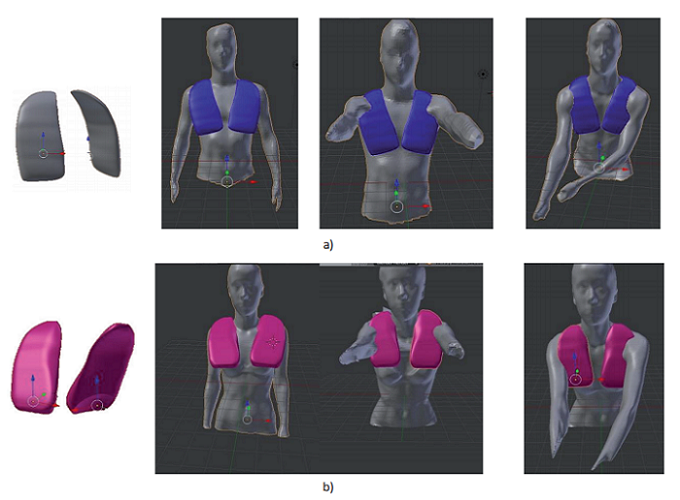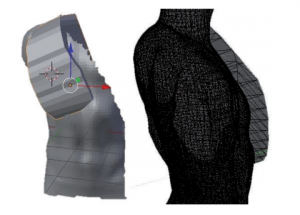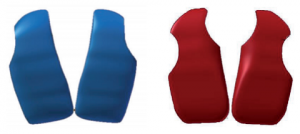Researchers Use 3D Printing, Scanning, and Modeling to Make Customized Protective Gear for Field Hockey
While playing sports is great fun and can be a great workout as well, it can also be dangerous. That’s why there’s been a lot of research centered around keeping athletes safe by using 3D printing to make better protective gear.
 A pair of researchers who are members of the faculty of Textile Technology at the University of Zagreb in Croatia recently published a paper, titled “3D Technologies in Individualized Chest Protector Modelling,” about using 3D scanning, modeling, and printing to design a field hockey chest protector.
A pair of researchers who are members of the faculty of Textile Technology at the University of Zagreb in Croatia recently published a paper, titled “3D Technologies in Individualized Chest Protector Modelling,” about using 3D scanning, modeling, and printing to design a field hockey chest protector.
The abstract reads, “In the clothing’s industry, 3D scanning the human body is digitalized, which is after that used in computer software packages for custom-made clothing. Except for the fashion industry, there is a need for individualized protective work clothing and equipment production in other industries as well. The possibility of applying new technologies such as 3D scanning and 3D modelling of protective elements that can be made by using 3D printers is presented in this paper. In order to design a field hockey chest protector, male and female subjects were scanned using a 3D body scanner in several different positions specific to the sport. The chest protector was constructed and modelled based on the digitalized images. Software packages were used which enable point clouds preparation of the digitalized human body for constructing the protector, its modelling and preparation of virtually designed protectors for 3D printing. An individualized chest protector is modelled using a software program called Bender. The protector is integrated into the clothing item, completely follows the body shape and provides the necessary protection.”
Human bodies can be digitalized by using 3D body scanners, which forms spatial coordinates of point clouds that can be processed further and have various applications in the medical, scientific, film, and clothing industries. These point clouds can be used when taking measurements, or for a virtual representation of how clothing will fit a specific person. Not only does custom-made protective clothing fit better this way, it also offers better protection.
In terms of protectors for field hockey players, these are typically made out of polymeric materials that have high durability and firmness, though textiles should also be used for protection purposes. To model a chest protector for the specific purposes of field hockey, the team took 3D body scans of players in specific positions, prepared a point cloud for 3D chest protection modeling, and created a 3D model for 3D printing. 3D scanning was performed with the university’s VisualSmart 3D body scanner, which resulted “in a point cloud containing about 500 000 spatial coordinates.”
With the ScanWorx software package, it took less than a minute to process the data and create a point cloud for measuring and extracting the body shapes; Meshlab and Blender software were also used for point cloud editing and 3D modeling the chest protector.
“When constructing an individualized chest protector, different 3D modelling methods can be applied, depending on the software package and input data used in 3D modelling. When it comes to human body digitalization, the obtained data are not fully structured. It is necessary to find 3D modelling methods that will ensure shapes suitable for 3D printing. Therefore, it is possible to define a simple geometric body with finite object dimensions which is then modelled. A cube, cuboid or sphere are usually used as the base,” the researchers explained. “Another 3D modelling method is a construction of the base that is modelled according to a scanned object. In other words, it has its own shape and volume which is multi plied and built in layers into a 3D object. The third possibility of modelling is constructing a structured mesh that fully follows the scanned 3D object. When defining the area for which the protector has to be made, the volume of the protector is determined. The aforementioned 3D modelling procedures result in a structured 3D mesh that is suitable for 3D printing.”
3D modeling was used to to create a cuboid shape, which outlines the chest protector; an increased number of edges within the cuboid allowed the researchers to form a structured mesh that would define the external shape of the protector. Then its inner side was modeled, according to the 3D scanned portion of the point cloud, to precisely follow the body shape.
“As a result, functions which enable modelling of protector structured mesh by “imprinting“ part of the point clouds into the prepared chest protector shape were used,” the researchers wrote. “As the etalon, the point cloud of 3D scanned human body was used in the standard scanning position.”
Virtual fit testing showed that the chest protector for the opposite side of the body could not be a mirror image to the first, so it was corrected according to body shape. There is also a difference in shape between the chest protectors for male bodies and the ones for female bodies, specifically in the width of the shoulder “and the angle at which the protector lies on the chest of the female body.”
“Based on the results presented in this paper, it can be concluded that 3D technologies can be successfully used in the modelling of protection elements for the human body 3D scanning, 3D modelling, and 3D printing require knowledge of 3D technology and its use in order to develop objects for individual purposes,” the researchers concluded. “3D chest protectors modelling according to real body shapes and specific purposes indicate the need for using sophisticated equipment that will provide adequate protection. Modelling of protective elements can increase the level of protection, as shown, because body asymmetry can be taken into consideration during development, as well as the specific body positions in which the protection is used.”
Co-authors of the paper are Paula Milosevic and Slavica Bogovic.
Discuss this research and other 3D printing topics at 3DPrintBoard.com or share your thoughts below.
Subscribe to Our Email Newsletter
Stay up-to-date on all the latest news from the 3D printing industry and receive information and offers from third party vendors.
Print Services
Upload your 3D Models and get them printed quickly and efficiently.
You May Also Like
Making 3D Printing Personal: How Faraz Faruqi Is Rethinking Digital Design at MIT CSAIL
What if your 3D printer could think more like an intelligent assistant, able to reason through a design idea, ask questions, and deliver something that works exactly the way the...
Reinventing Reindustrialization: Why NAVWAR Project Manager Spencer Koroly Invented a Made-in-America 3D Printer
It has become virtually impossible to regularly follow additive manufacturing (AM) industry news and not stumble across the term “defense industrial base” (DIB), a concept encompassing all the many diverse...
Heating Up: 3D Systems’ Scott Green Discusses 3D Printing’s Potential in the Data Center Industry
The relentless rise of NVIDIA, the steadily increasing pledges of major private and public investments in national infrastructure projects around the world, and the general cultural obsession with AI have...
Formlabs Teams Up with DMG MORI in Japan
In late June, Nick Graham, Chief Revenue Officer at Formlabs, announced on LinkedIn that the company had partnered with DMG MORI, one of the world’s leading machine tool companies, to...





































